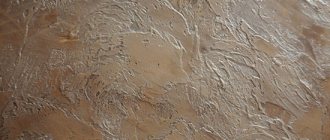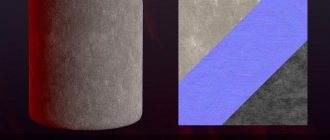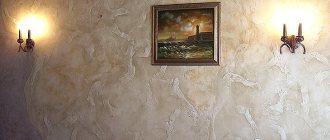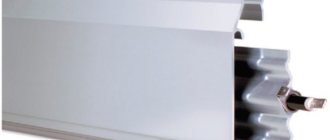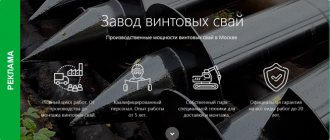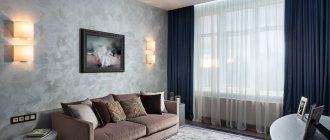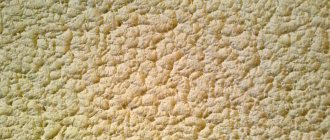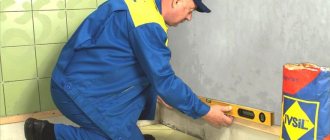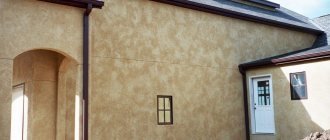Beton-House.com
Website about concrete: construction, characteristics, design. We combine the experience of professionals and private craftsmen in one place
Decorative plaster
Concrete walls are an ultra-fashionable and stylish solution for a modern interior. They came to us along with such styles as hi-tech and loft. Despite the monochrome and rough texture of the walls, they are able to make the interior warm and cozy. Concrete walls themselves require finishing to protect their porous, vapor-permeable surface.
Modern decorative concrete-like plaster comes to the rescue. Its use allows you to protect a concrete wall, as well as recreate the required texture on surfaces made of any materials. Therefore, stylish concrete walls in the interior have become available to everyone.
What is decorative plaster for concrete?
The secret of a good renovation is perfect walls. To decorate an apartment in the currently fashionable loft, grunge or military styles, decorative concrete-like plaster is ideal. These are special mixtures based on microcement or microconcrete. Using them, walls are finished quickly and efficiently, and different textures are reproduced. After renovation, the apartment looks creative and fashionable.
Concrete plaster
Decorative concrete plaster is used to decorate various rooms:
- commercial;
- industrial;
- residential
It successfully complements the interior and combines with:
- plank floors;
- glass windows;
- wooden furniture;
- brick partitions;
- iron decorative objects - lamps, chairs and others.
Which paint to choose?
To radically change the color scheme of concrete walls, it is worth using special paint materials. The range of paints is not so wide, but you need to know which one is better to choose in a particular case.
Let's look at what paints are best for covering walls:
- The most successful choice would be acrylic paint, which contains synthetic fibers. This composition will be spread evenly over the concrete. The possibility of saturation of the substance with moisture is excluded.
- Oil paints are also suitable for use in this finish, but it is important to consider some additional operating conditions. To protect the integrity of the repair in the future, it is worth choosing manufacturers who make oil paint for painting concrete.
- You can use other paints that contain latex resins.
Depending on further operating conditions, the basic composition of the paint is determined. Sometimes more natural ingredients are required, for example, in wet rooms - moisture resistant. For the facade of a building, a synthetic base will be an ideal solution.
Features and types of plaster
Dry, ready-made plastic mixtures for plastering are available in stores. They differ in composition, advantages, and disadvantages from conventional cement. They contain various additives and additives that improve properties. The mixtures also contain sand, small pebbles or stone chips to result in a rough, heterogeneous “playing” wall.
Manufacturers produce mixtures based on microcement or microconcrete.
| Base microcement | Micro concrete base | |
| Compound | Aqua cement, microfino, polymer additives, dye, no mineral chips | Cement, modifying additives, resins, dye, quartz chips |
| Application area | Interior, bathroom, toilets, furniture | External and internal works |
| Mix structure | Very thin, homogeneous | Porous |
| Properties | Resistance to salts and chlorine, high humidity | High plasticity, adhesion, hygroscopicity |
Principles of application
The originally implemented sloppy relief adds a special “zest” to the decoration of the room. The use of this building material makes it possible to recreate unique textures using various construction techniques. They are made in a wide shade palette of gray and other colors, which in turn increases the scope of application.
Microconcrete can be polished to perfect smoothness. The plasticity of the finished solution is quite high; it becomes possible to slowly create the relief, in agreement with the developed finishing solution. The long-lasting flexibility of the mass allows you to apply wall figures using polymer stencils.
Advantages and disadvantages
Any material has advantages and disadvantages. The advantages of concrete compositions outweigh their disadvantages.
The material is lightweight, but at the same time durable. Any walls covered with these mixtures do not become heavier.
The coating is heat resistant. Applying concrete plaster is permissible on a metal, plastic or wooden base. The composition has good adhesion to the material it is coated with. Another advantage is the fact that decorative plaster for concrete does not absorb any foreign odors (even the strongest ones).
Classification of decorative plaster by types of fillers
Mixtures based on aquacement are highly resistant to moisture. Using them in rooms with constantly high humidity is an excellent solution to the problem. The advantages of plastered walls include resistance to mold, mechanical stress, and non-flammability.
The concrete composition is easy to apply and dries quickly. With its help you can create various patterns and decorative effects. Surfaces covered with this plaster are easy to clean and resistant to chemicals.
After applying the composition, there is no construction waste left. Plaster goes well with other materials used in the interior. Using mixtures, they eliminate and hide defects on the surface of the walls. The compositions also have good sound and noise-absorbing properties.
Despite the advantages, there are still disadvantages. Decorative plaster for concrete is not a cheap finishing material. In addition, when carrying out work, the mixtures have a toxic effect on the body, so follow the instructions for use and observe safety regulations.
Tools needed to simulate a concrete wall
To create the effect of a concrete wall using decorative plaster, the following tools are needed:
- metal trowel - necessary for applying the composition without joints and leveling it, also suitable for creating some decorative effects. The catalog of the Sanmarco-Vernici online store presents trowels from the Pavan company. You can choose a stainless steel tool with a wooden, plastic or rubberized handle, sizes 200*80, 240*100;
- stone sponge - used for applying glaze coating;
- a metal brush made of thin wire - necessary to create a shading effect;
- mat - to create roughness;
- spatula - for applying coating in places hard to reach with a trowel, forming a pattern, applying material to the trowel;
- level - to level the surface.
Technology of applying plaster under concrete
At the preliminary stage, it is necessary to prepare tools and personal protective equipment. It’s easy to make a list of them based on the advice of professionals:
- Apply the composition using gloves, respiratory protection (respirator, protective mask), vision protection (glasses, transparent shield).
- Before applying plaster, the surface is cleaned of old coating. To prepare the walls, the ideal solution would be a grinding machine, spatulas, and sandpaper of various grain sizes.
- To apply the mixture, use a spatula, a trowel for layer-by-layer application, and a sponge for shading.
- To work, you will need a bucket or large container for diluting the dry mixture, an electric drill, and a mixer attachment for mixing.
The mixtures are sold both dry and ready-made, already diluted.
Before applying a new coating, prepare the surface:
- the old coating is removed;
- irregularities are removed;
- obvious defects are eliminated - cracks, chips, potholes;
- covered with primer (after this the surface must dry completely).
Then decorative mixtures are applied. If the composition is purchased in dry form, it is diluted following the manufacturer's instructions.
It is important to remember that concrete plaster sets instantly, in about 30-40 minutes. Work quickly or do not dilute too much dry mixture at once. At the end of the process, the surface is covered with 3 layers of protective varnish to prevent destruction.
Apply layer-by-layer plaster under the concrete:
- Base layer. Its thickness is determined by the size of the granular inclusions present in the composition. The layer must dry completely, then it is sanded with sandpaper (grit up to 130).
- The main (or intermediate) layer. It is left raw, since here a texture (pattern) is formed on the surface. Using a sponge, broom or corner of a spatula, create streaks, scratches, and strokes. Next, the layer should dry. After this, it can be adjusted using sandpaper.
- Special impregnation against moisture (if necessary).
- Ironing and polishing. Rub the surface with wax. The easiest way to do this is with a sanding machine with a soft felt or wool attachment.
A simple and quick way to apply decorative plaster under concrete - video tutorial.
Advantages and disadvantages
Fashionable building materials make it possible to implement creative solutions using repair and finishing procedures. It is preferred by highly professional artists, qualified builders and equally novice specialists who have mastered finishing technology.
Decorative finishing for concrete has a lot of positive advantages:
- Simply and efficiently transferred to the walls.
- Plastered surfaces demonstrate the sophistication of the interior.
- Reduces costs for finishing work.
- Harmonious combination with diverse building materials.
- Provides deep texture.
- Stability to the influence of various natural factors.
- Expanded range of color solutions.
- Good performance: low thermal conductivity, noise reduction, create comfort and coziness in the room.
- High adhesion to a variety of surfaces. The paste mixture flows freely onto metal, concrete areas, brick and stone.
- Long service life.
- Regardless of the size of the applied layer, the hardened plaster mixture does not form a significant weight stress on the building structure.
- It does not require preparation of a homogeneous surface before application, since the relief conceals errors and compensates for convexities.
Despite the abundance of advantages, there are also some negative features:
- Long drying time.
- The facing mortar has a long hardening process due to the low-speed stage of moisture evaporation.
- High cost and price.
Famous manufacturers
The leaders of the Russian market are firmly held by five compounds recognized by builders:
- Knauf (Germany). Products are high quality and inexpensive. Plasters for concrete are produced on the basis of Knauf Diamond cement. There are 4 varieties sold in stores to create different surface options: rough, granular structure (coat), grooved (bark beetle), with different fractions of inclusions. Base color is white. But after plastering, painting in any other shade is acceptable. Suitable for external and internal work. After application, plastered surfaces are resistant to moisture and light mechanical stress. Easily tolerate high humidity. Not bad for insulation, sound insulation.
- San Marco (Italy). With the help of these mixtures, durable cement patterns are created in the interior. Concrete plaster is durable, breathable, and harmless to humans. Consists of cement with acrylic-siloxane copolymers. Using plaster, you can easily achieve the effect of aged concrete or formwork. Price segment – premium. There are 30 types on the market. The advantage is economical consumption of material. On average it is 0.8-1.3 kg/m2.
- Spiver (Italy). So-called Venetian plasters. Used for external and internal work. Many types are sold, creating coatings with different effects: imitation marble, natural stone, shimmering crystals, velvet, craquelure (crack effect) with inclusions. The consumption of the plaster mixture depends on the selected composition.
- VGT (Russia). There are 16 types of concrete plaster on sale with various texture effects, including bark beetle and Venetian. Suitable for external and internal work. Basically, these are textured mixtures with dolomite inclusions. Craftsmen achieve the effect of natural stone or concrete when decorating walls. The compositions are suitable for interiors with rough textured surfaces in loft and military styles.
- Lakra (Russia). Available in 3 versions. There is plaster for concrete with the effect of fur coat, bark beetle, graininess. Suitable for external and internal work. It is used for plastering walls and ceilings. Base color is white. They add color to the composition or paint surfaces already covered with plaster. High resistance to moisture, weathering, and mechanical stress. No more than 2 kg of solution is required per 1 m2 of surface.
What problems may arise when working with concrete?
This is a high-quality material, the construction of walls from which is labor-intensive, but the final result will last for many years. However, there are a number of problems that arise while working with the material.
- A common problem is that the surface breaks. Most often this occurs due to improper mixing of components.
- Too runny. The problem is too much water added during the creation of the material.
- Concrete bursts after a while. The fact is that during mixing, crushed stone of several fractions is used.
The problem is too much water added during the creation of the material.
Using plaster in the Loft style
One of the common types of finishing is plastering. Concrete-like plaster applied to the interior makes it easy to implement bold ideas. Imitation of a rough stone or concrete surface is popular and is actively used to decorate loft-style apartments.
Fans of the style are attracted by the brutality and the impression of reliability of the walls. People feel protected. This interior, in ensemble with the minimalist decoration of the apartment, gives such a feeling.
Gray concrete has different shades and a rich range of colors. In combination with interior items in loft solutions, it looks perfect. Concrete and stone with a feeling of cold emphasize the warmth of natural materials, which are additionally used in furnishing an apartment or house.
Decorative plaster for concrete in the interior
Tools for surface preparation and plastering
If you are wondering how to make a concrete wall in the interior of an apartment with your own hands, start by purchasing the tools necessary for the plastering process.
So, you will need:
- Spatulas and trowels;
- Plastering rule;
- Hammer and chisel for removing the old layer of plaster, repairing the surface, etc.;
- Rollers;
- Paint baths;
- Grater with attachments of different grain sizes;
- Various rollers, stencils, stamps and other tools for creating relief, texture and patterns.
At different stages of preparation for work and the process of plastering the wall itself, other additional tools may be needed.
A set of necessary tools
Advice: the basic set of tools can be purchased in the same department where plaster is purchased - experienced consultants will also be able to help you choose the options that are suitable for your purposes.
Pure concrete without finishing
One of the most controversial options. On the one hand, the solution simplifies finishing and indicates the possibility of significant cost savings. But, on the other hand, it determines only precise and constructive tasks, because there are practically no alternatives left after the main stages of construction and casting of concrete parts. If you decide to work with pure concrete, you need to select a design project long before the start of construction, visualize it, carefully study it and make changes if errors are discovered.
This means working not only with the size and shape of the main elements of walls, columns, load-bearing structures, beams and ceilings, but also marking and producing holes and openings for lighting equipment, fastening furniture and object decor. The stylization of the premises, the color and texture of the concrete in accordance with the design requirements, and the basic installation of various mortgages, fastenings, screeds, and platforms are taken into account.
Complex work at the design stage facilitates subsequent finishing and decoration. Saving money remains a controversial issue, since the absence of serious expenses at the final stages of decorating the premises does not at all exclude expenses during the complex development of project documentation, taking into account numerous details!
